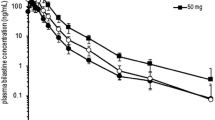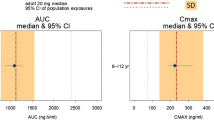Summary
Rupatadine is a new oral antihistaminic agent used for the management of allergic inflammatory conditions, such as rhinitis and chronic urticaria. The aim of the present study was to develop a population pharmacokinetic/pharmacodynamic (PKPD) model for the description of the effect of rupatadine and one of its active metabolites, desloratadine, on the histamine-induced flare reaction and to predict the response to treatment after repeated administrations of rupatadine. Both rupatadine and desloratadine were characterized by two-compartmental kinetics. For both compounds, covariates sex and weight had a significant effect on several parameters. The pharmacodynamics were described by an indirect model for the inhibition of flare formation that accounted for the contribution of both rupatadine and desloratadine to the antihistaminic effect. The final PKPD model adequately described the original data. The simulated response after repeated once-daily administrations of 10 mg rupatadine showed a significant and maintained antihistaminic effect over time, between two consecutive dosing intervals.
Similar content being viewed by others
References
Keam S.J., Plosker G.L. (2007): Rupatadine: a review of its use in the management of allergic disorders. Drugs, 67(3), 457–474.
Izquierdo I., Valero A., Garcia O., Pérez I., Mullol F., van Cauwenberge P. (2005): Clinical efficacy of rupatadine under ARIA criteria: pooled analysis. Allergy Clin. Immunol Int., Suppl. 1. Abst. 728, 271.
Martínez-Cócera C, de Molina M., Martí-Guadaño E., Pola J., Conde J., Borja J. et al. (2005): Rupatadine 10 mg and cetirizine 10 mg in seasonal allergic rhinitis: a randomised, double-blind parallel study. J. Investig. Allergol. Clin. Immunol., 15, 22–29.
Saint-Martí F., Dumur J.P., Pérez I., Izquierdo I.; French Rupatadine-Rhinitis Study Group (2004): A randomized, double-blind, parallel-group study, comparing the efficacy and safety of rupatadine (20 and 10 mg), a new PAF and H1 receptor-specific histamine antagonist, to loratadine 10 mg in the treatment of seasonal allergic rhinitis. J. Investig. Allergol. Clin. Immunol., 14, 34–40.
Guadaño E.M., Serra-Batlles J., Meseguer J., Castillo J.A., de Molina M., Valero A. et al. (2004): Rupatadine 10 mg and ebastine 10 mg in seasonal allergic rhinitis: a comparison study. Allergy, 59, 766–771.
Barbanoj M.J., Garíafa-Gea C., Morte A., Izquierdo I., Pérez I., Jané F. (2004): Central and peripheral evaluation of rupatadine, a new antihistamine/platelet-activating factor antagonist at different doses in healthy volunteers. Neuropsy-chobiology, 50, 311–321.
Merlos M., Giral M., Balsa D., Ferrando R., Queralt M., Puigdemont A. et al. (1997): Rupatadine, a new potent, orally active dual antagonist of histamine and platelet-activating factor (PAF). J. Pharmacol. Exp. Ther., 280(1), 114–121.
Heykants J.J.P., Snoeck E., Awouters F., Van Peer A. (1992): Antihistamines. In: Van Boxtel C.J., Holford N.H.G, Danhof M. (eds). The In Vivo Study of Drug Action. Amsterdam: Elsevier Science Publishers, 337–356.
Urien S., Tillement J.P., Ganem B., Kuch M.D. (1999): A pharmacokinetic-pharmacodynamic modelling of the antihistaminic (HI) effects of cetirizine. Int. J. Clin. Pharmacol. Ther., 37(10), 499–502.
Deschamps C, Dubruc C, Mentre F., Rosenzweig P. (2000): Pharmacokinetic and pharmacodynamic modeling of mizolastine in healthy volunteers with an indirect response model. Clin. Pharmacol. Ther., 68(6), 647–657.
Beal S.L., Sheiner L.B. (1992): NONMEM User’s Guide. San Francisco: University of California.
Cockcroft D.W. & Gault M.H. (1976): Prediction of creatinine clearance from serum creatinine. Nephron, 16(1), 31–41.
Slater J.W., Zechnich A.D., Haxby, D.G. (1999): Secondgeneration antihistamines: a comparative review. Drugs, 57(1), 31–47.
Desager J.P., Horsmans Y. (1995): Pharmacokinetic-pharmacodynamic relationships of HI-antihistamines. Clin. Pharmacokinet., 28(5), 419–432.
Grant J.A. (2000): Molecular pharmacology of secondgeneration antihistamines. Allergy Asthma Proc., 21(3), 135–140.
Barron S., Roman J., Michelena P., Ramis I. & Merlos M. (2006): Rupatadine inhibits cytokine production and NF-κB activity by a histamine HI receptor-dependent mechanism. Rev. Rhinol., 6(1), 18.
Stuebner P., Horak F., Zieglmayer R., Arnáiz E., Leuratti C, Pérez I., et al. (2006): Effects of rupatadine vs placebo on allergen-induced symptoms in patients exposed to aeroallergens in the Vienna Challenge Chamber. Ann. Allergy Asthma Immunol., 96(1), 37–44.
Gabrielsson J., Weiner D. (2000): Pharmacokinetic and Pharmacodynamic Data Analysis: Concepts and Applications, 3rd edn. Stockholm: Swedish Pharmaceutical Press.
Author information
Authors and Affiliations
Rights and permissions
About this article
Cite this article
Peña, J., Carbo, ML., Solans, A. et al. Antihistaminic effects of rupatadine and PKPD modelling. Eur. J. Drug Metabol. Pharmacokinet. 33, 107–116 (2008). https://doi.org/10.1007/BF03191027
Received:
Issue Date:
DOI: https://doi.org/10.1007/BF03191027




